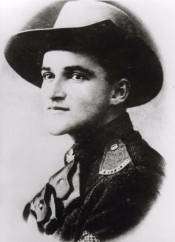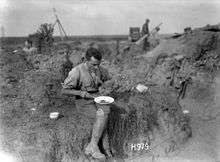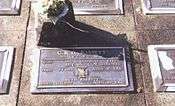Cyril Bassett
| Cyril Bassett | |
|---|---|
 Cyril Basset, circa 1915 | |
| Born |
3 January 1892 Mount Eden, Auckland, New Zealand |
| Died |
9 January 1983 (aged 91) Stanley Bay, New Zealand |
| Allegiance | New Zealand |
| Service/branch | New Zealand Military Forces |
| Years of service |
1909–29 1941–43 |
| Rank | Lieutenant Colonel |
| Battles/wars |
First World War Second World War |
| Awards | Victoria Cross |
Cyril Royston Guyton Bassett, VC (3 January 1892 – 9 January 1983) was a New Zealand recipient of the Victoria Cross (VC), the highest award for gallantry in the face of the enemy that can be awarded to British and Commonwealth forces. He was the first and only New Zealander to be awarded the VC in the Gallipoli Campaign of the First World War.
Born in Auckland, Bassett was a bank worker when the First World War began. A member of New Zealand's Territorial Force, he volunteered for service abroad with the New Zealand Expeditionary Force (NZEF) and was posted to the New Zealand Divisional Signal Company as a sapper. He saw action on the opening day of the Gallipoli Campaign, and it was during the Battle of Chunuk Bair that he performed the actions that led to his award of the VC. Medically evacuated due to sickness shortly after the battle, he later served on the Western Front and finished the war as a second lieutenant. He returned to the banking profession but was recalled to active duty during the Second World War. He served on the Home Front and by the time he was taken off active duty in December 1943, he had been promoted to the rank of lieutenant colonel and was commander of signals in the Northern Military District. When he retired from his banking career he became a justice of the peace in Devonport. He died in 1983 at the age of 91.
Early life
Cyril Bassett was born on 3 January 1892 in Auckland, New Zealand to a printer, Frederick Bassett, and his wife, Harriet.[1] After completing his formal education, Bassett worked as a clerk for the National Bank of New Zealand. In 1909, he joined what later became the Territorial Force and was assigned to the Auckland College Rifles. Two years later he transferred to the Auckland Divisional Signal Company.[2]
First World War
When the First World War broke out, it was Bassett's intention to join the Royal Navy. However, his mother, who was from a family with a history of service in the British Army, convinced him to enlist in the New Zealand Military Forces. Bassett was not particularly tall and was initially rejected due to his lack of height. He persisted with his attempt to enlist,[2] and eventually joined the New Zealand Expeditionary Force (NZEF) as a sapper in the Corps of New Zealand Engineers, assigned to the New Zealand Divisional Signal Company.[1]
Bassett embarked with the main body of the NZEF for the Middle East in October 1914. Initially based in Egypt, after a period of training, he landed at ANZAC Cove on 25 April 1915, the opening day of the Gallipoli Campaign.[1] Along with the other signallers of his unit, he was immediately set to work laying communication lines. In early May, his courage under fire was noted in consideration for a gallantry award.[2]
Later in the campaign, Bassett was promoted to corporal. In August 1915, a series of offensives against Turkish positions along the Gallipoli front were planned to break the stalemate that had developed since the initial landing. On 7 August, the New Zealand Infantry Brigade attacked Chunuk Bair, a prominent hill overlooking the battlefield. The battle lasted for three days, with Chunuk Bair captured by the brigade's Wellington Infantry Battalion on the second day, during which Bassett, in command of a section of five other signallers of his unit, laid down and maintained telephone lines between brigade headquarters and the front lines. He braved continuous gunfire during this time. Although not wounded, two bullets passed through the fabric of his tunic during the fighting. After the battle, his name, along with those of the other five signallers of his section, was collected by Major Arthur Temperley of brigade headquarters, who nominated Bassett for the Victoria Cross (VC).[2]

The citation for Bassett's Victoria Cross read as follows:[3]
No. 4/515 Corporal Cyril Royston Guyton Bassett, New Zealand Divisional Signal Company. For most conspicuous bravery and devotion to duty on the Chunuk Bair ridge in the Gallipoli Peninsula on 7th August, 1915. After the New Zealand Infantry Brigade had attacked and established itself on the ridge, Corporal Bassett, in full daylight and under a continuous and heavy fire, succeeded in laying a telephone line from the old position to the new one on Chunuk Bair. He has subsequently been brought to notice for further excellent and most gallant work connected with the repair of telephone lines by day and night under heavy fire.— The London Gazette, No. 29238, 15 October 1915
The citation incorrectly refers to Bassett's actions on 7 August; it was not until the following day that the Wellington Infantry Battalion captured Chunuk Bair. A few days after the battle, Bassett was evacuated from Gallipoli due to poor health. Suffering from dysentery, he spent several months recuperating in England. In June 1916, he rejoined his unit, by then on the Western Front in France as part of the New Zealand Division. Later that year, he participated in the Battle of the Somme and in 1917 was commissioned as a second lieutenant. He was wounded twice during his time in France. He returned to New Zealand in late 1918 as the New Zealand Division started demobilising and was formally discharged from the NZEF in 1919.[2]
Interwar period and Second World War
Bassett returned to his banking career after the war, managing branches of the National Bank in Auckland and later in Paeroa. He retained a link to the military, rejoining the Territorial Force but was placed on the retired list of officers in 1929. By 1939 he was manager of the Auckland Town Hall branch of the National Bank. He had also married, his union with Ruth Louise Grant producing two daughters.[1]
Called up for the National Military Reserve as a result of the outbreak of the Second World War, Bassett was placed on active duty in 1941 as a captain in the Royal New Zealand Corps of Signals. He was not required to serve overseas and instead he worked in signals while remaining in New Zealand. Promoted to major in February 1942, his active war service ended in December 1943.[2] By then he had achieved the rank of lieutenant colonel and was commander of signals in the Northern Military District.[1]
Later life and legacy

Bassett returned to the National Military Reserve from which he eventually retired in 1948. As a civilian, he once again resumed his banking profession. He retired in 1952 but remained active in the community of Devonport, Auckland as a justice of the peace. He died in Stanley Bay, Auckland on 9 January 1983, shortly after his 91st birthday,[1] and his ashes were buried at North Shore Memorial Park.[4] He was survived by his two daughters and his wife.[1] His VC, gifted to the Corps of Signals upon his death, is displayed at the Auckland War Memorial Museum.[2][5]
According to his daughter, Bassett rarely spoke about his achievements as "It just wasn't done",[6] and in fact, she did not learn of her father's award until she studied Gallipoli at primary school. He was modest of his achievements and expressed embarrassment at being the only New Zealand VC recipient of the Gallipoli Campaign.[2]
Bassett remains the only signaller to have been awarded the VC and was a lifetime member of the Corps of Signals Association. In recognition of Bassett's rank at the time he won the VC, the Bassett Memorial Trophy is awarded annually to the most outstanding corporal in the Corps of Signals. The trophy is a statue of Bassett on Chunuk Bair.[2]
Notes
- 1 2 3 4 5 6 7 Barber, Laurie. "Bassett, Cyril Royston Guyton 1892–1983". Dictionary of New Zealand Biography. Ministry for Culture and Heritage. Retrieved 28 December 2012.
- 1 2 3 4 5 6 7 8 9 Harper & Richardson 2007, pp. 113–118.
- ↑ The London Gazette: no. 29238. p. 10154. 15 October 1915. Retrieved 28 December 2012.
- ↑ "North burial and cremation records search". Auckland Council. Retrieved 11 December 2014.
- ↑ "medal, decoration". Auckland War Memorial Museum. Retrieved 2015-11-22.
- ↑ Eames, David (24 April 2009). "Gallipoli hero downplayed his achievement". The New Zealand Herald. Retrieved 26 September 2011.
References
| Wikimedia Commons has media related to Cyril Bassett. |
- Harper, Glyn; Richardson, Colin (2007). In the Face of the Enemy: The Complete History of the Victoria Cross and New Zealand. Auckland, New Zealand: HarperCollins Publishers (New Zealand) Limited. ISBN 1869506502.